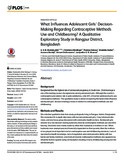| dc.contributor.author | Shahabuddin, A. S. M. | |
| dc.contributor.author | Nöstlinger, Christiana | |
| dc.contributor.author | Delvaux, Thérèse | |
| dc.contributor.author | Sarker, Malabika | |
| dc.contributor.author | Bardají, Azucena | |
| dc.contributor.author | Brouwere, Vincent De | |
| dc.contributor.author | Broerse, Jacqueline E. W. | |
| dc.date.accessioned | 2018-01-01T10:39:41Z | |
| dc.date.available | 2018-01-01T10:39:41Z | |
| dc.date.issued | 2016-06-23 | |
| dc.identifier.citation | Shahabuddin ASM, Nöstlinger C, Delvaux T, Sarker M, Bardají A, Brouwere VD, et al. (2016) What Influences Adolescent Girls’ Decision-Making Regarding Contraceptive Methods Use and Childbearing? A Qualitative Exploratory Study in Rangpur District, Bangladesh. PLoS ONE 11(6): e0157664. https://doi.org/10.1371/journal.pone.0157664 | en_US |
| dc.identifier.uri | http://hdl.handle.net/10361/8825 | |
| dc.description | This article was published in the PLoS ONE[© 2016 PLoS ONE ] and the definite version is available at : https://doi.org/10.1371/journal.pone.0157664
. The Journal's website is at: http://journals.plos.org/plosone/article?id=10.1371/journal.pone.0157664 | en_US |
| dc.description.abstract | Background: Bangladesh has the highest rate of adolescent pregnancy in South Asia. Child marriage is one of the leading causes of pregnancies among adolescent girls. Although the country's contraceptive prevalence rate is quite satisfactory, only 52% of married adolescent girls use contraceptive methods. This qualitative study is aimed at exploring the factors that influence adolescent girls' decision-making process in relation to contraceptive methods use and childbearing. Methods and results: We collected qualitative data from study participants living in Rangpur district, Bangladesh. We conducted 35 in-depth interviews with married adolescent girls, 4 key informant interviews, and one focus group discussion with community health workers. Adolescent girls showed very low decision-making autonomy towards contraceptive methods use and childbearing. Decisions were mainly made by either their husbands or mothers-in-law. When husbands were unemployed and financially dependent on their parents, then the mothers-in-law played most important role for contraceptive use and childbearing decisions. Lack of reproductive health knowledge, lack of negotiation and communication ability with husbands and family members, and mistrust towards contraceptive methods also appeared as influential factors against using contraception resulting in early childbearing among married adolescent girls. Conclusions: Husbands and mothers-in-law of newly married adolescent girls need to be actively involved in health interventions so that they make more informed decisions regarding contraceptive use to delay pregnancies until 20 years of age. Misunderstanding and distrust regarding contraceptives can be diminished by engaging the wider societal actors in health intervention including neighbours, and other family members. | en_US |
| dc.language.iso | en | en_US |
| dc.publisher | © 2016 Plos One | en_US |
| dc.relation.uri | http://journals.plos.org/plosone/article?id=10.1371/journal.pone.0157664 | |
| dc.subject | Adolescent | en_US |
| dc.subject | Childbearing | en_US |
| dc.subject | Rangpur | en_US |
| dc.title | What influences adolescent girls’ decision-making regarding contraceptive methods use and childbearing? a qualitative exploratory study in Rangpur district, Bangladesh | en_US |
| dc.type | Article | en_US |
| dc.description.version | Published | |
| dc.identifier.doi | https://doi.org/10.1371/journal.pone.0157664 | |

